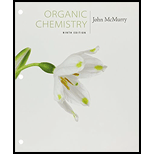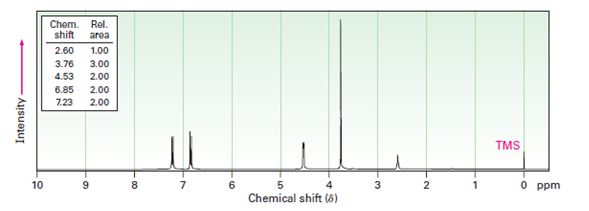
Concept explainers
Interpretation:
A structure for the alcohol with molecular formula C9H12O and the following spectral data is to be proposed.
1HNMR: 0.88 δ (triplet,Rel.area=3.00); 1.80 δ (quintet, Rel.area=2.00); 2.32 δ (Rel.area=1.00); 4.54 δ (triplet, Rel.area=1.00); 7.24 δ (Rel.area=5.00).
Concept introduction:
In 1HNMR spectrum, the alcoholic proton absorption occurs in the range 3.4 δ - 4.5 δ while that of phenolic proton occur in the range 3.0 to 8.0. The
The absorption due to 10 alkyl group (CH3) is seen around 0.7 δ - 1.3 δ, that due to a 20 alkyl group (CH2) is seen around 1.2 δ - 1.6 δ while that due to 30 alkyl group (CH) is seen around 1.4 δ - 1.8 δ The multiplicity of a signal gives an idea about the protons present in the adjacent carbons.
To propose:
A structure for the alcohol with molecular formula C9H12O and the following spectral data is to be proposed.
1HNMR: 0.88 δ (triplet,Rel.area=3.00); 1.80 δ (quintet, Rel.area=2.00); 2.32 δ (Rel.area=1.00); 4.54 δ (triplet, Rel.area=1.00); 7.24 δ (Rel.area=5.00).
b)
C8H10O2

Interpretation:
A structure for the alcohol with molecular formula C8H10O2 and the following spectral data is to be proposed.
IR: 3500 cm-1,
1HNMR: 2.60 δ (Rel.area=1.00); 3.76 δ (Rel.area=3.00); 4.53 δ (Rel.area=2.00); 6.85 δ (Rel.area=2.00); 7.23 δ (Rel.area=2.00).
Concept introduction:
In 1HNMR spectrum, the alcoholic proton absorption occurs in the range 3.4 δ - 4.5 δ while that of phenolic proton occur in the range 3.0 to 8.0. The aromatic protons give a broad peak in the range 6.5 δ - 8.0 δ, the benzylic protons normally absorb in the region 2.3 δ - 3.0 δ.
To propose:
A structure for the alcohol with molecular formula C8H10O2 and the following spectral data is to be proposed.
1HNMR: 2.60 δ (Rel.area=1.00); 3.76 δ (Rel.area=3.00); 4.53 δ (Rel.area=2.00); 6.85 δ (Rel.area=2.00); 7.23 δ (Rel.area=2.00).
Trending nowThis is a popular solution!

Chapter 17 Solutions
Student Value Bundle: Organic Chemistry, + OWLv2 with Student Solutions Manual eBook, 4 terms (24 months) Printed Access Card (NEW!!)
- Hi, I need your help with the drawing, please. I have attached the question along with my lab instructions. Please use the reaction from the lab only, as we are not allowed to use outside sources. Thank you!arrow_forwardHi, I need your help i dont know which one to draw please. I’ve attached the question along with my lab instructions. Please use the reaction from the lab only, as we are not allowed to use outside sources. Thank you!arrow_forward5. Write the formation reaction of the following complex compounds from the following reactants: 6. AgNO₃ + K₂CrO₂ + NH₄OH → 7. HgNO₃ + excess KI → 8. Al(NO₃)₃ + excess NaOH →arrow_forward
- Indicate whether the product formed in the reaction exhibits tautomerism. If so, draw the structure of the tautomers. CO₂C2H5 + CH3-NH-NH,arrow_forwardDraw the major product of this reaction N-(cyclohex-1-en-1-yl)-1-(pyrrolidino) reacts with CH2=CHCHO, heat, H3O+arrow_forwardDraw the starting material that would be needed to make this product through an intramolecular Dieckmann reactionarrow_forward
- Draw the major product of this reaction. Nitropropane reacts + pent-3-en-2-one reacts with NaOCH2CH3, CH3CHOHarrow_forwardIndicate whether the product formed in the reaction exhibits tautomerism. If so, draw the structure of the tautomers. OC2H5 + CoHs-NH-NH,arrow_forwardExplain how substitutions at the 5-position of barbituric acid increase the compound's lipophilicity.arrow_forward
- Explain how substitutions at the 5-position of phenobarbital increase the compound's lipophilicity.arrow_forwardName an interesting derivative of barbituric acid, describing its structure.arrow_forwardBriefly describe the synthesis mechanism of barbituric acid from the condensation of urea with a β-diketone.arrow_forward

 Organic ChemistryChemistryISBN:9781305580350Author:William H. Brown, Brent L. Iverson, Eric Anslyn, Christopher S. FootePublisher:Cengage Learning
Organic ChemistryChemistryISBN:9781305580350Author:William H. Brown, Brent L. Iverson, Eric Anslyn, Christopher S. FootePublisher:Cengage Learning

